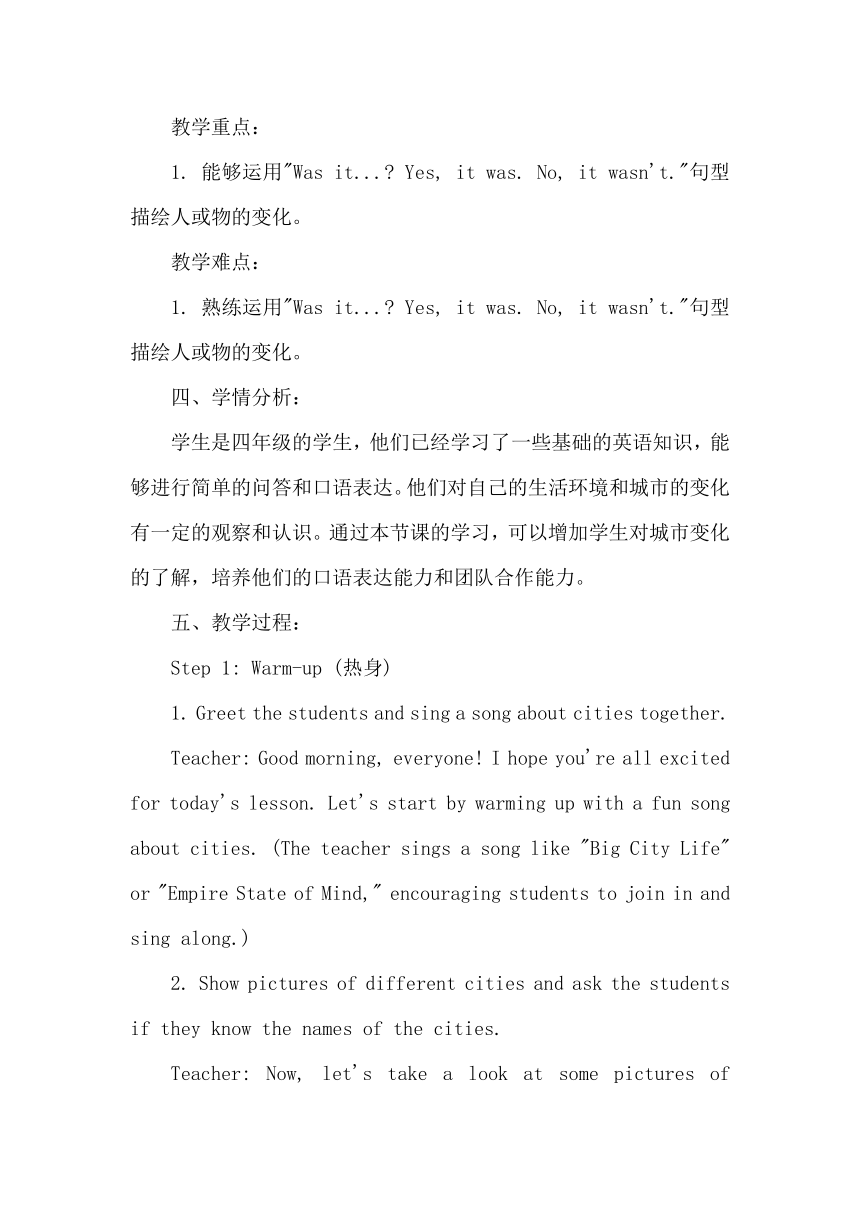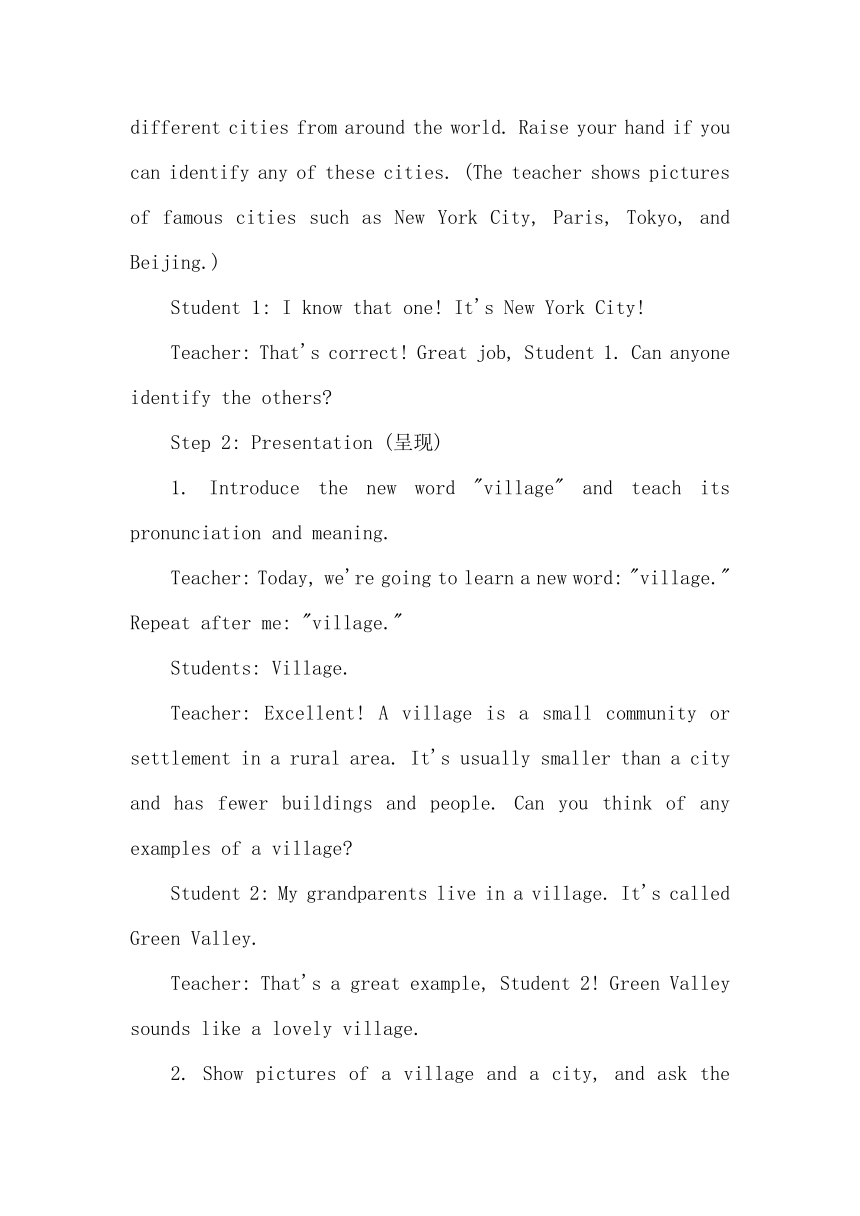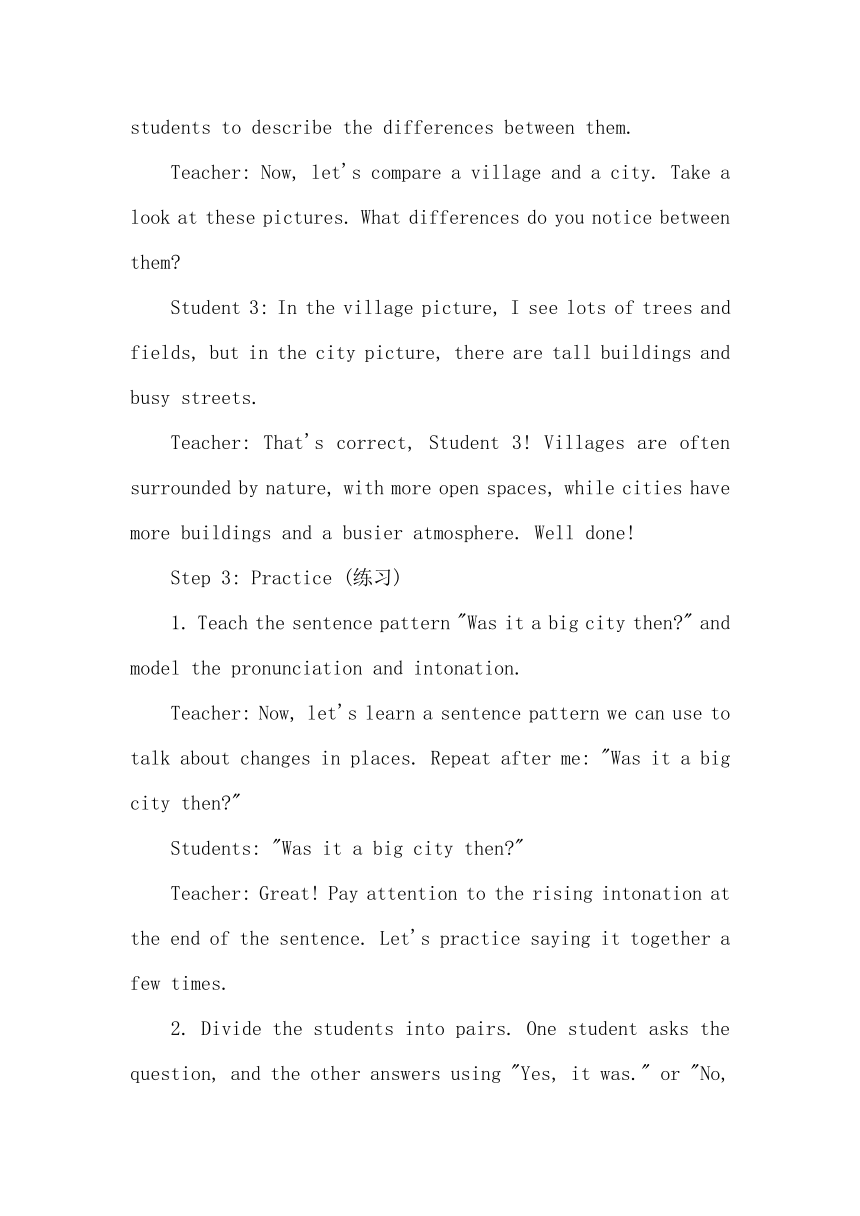Module 6 Unit 2 Was it a big city then?教案
文档属性
| 名称 | Module 6 Unit 2 Was it a big city then?教案 |  | |
| 格式 | docx | ||
| 文件大小 | 15.1KB | ||
| 资源类型 | 教案 | ||
| 版本资源 | 外研版(三年级起点) | ||
| 科目 | 英语 | ||
| 更新时间 | 2024-03-12 08:08:55 | ||
图片预览




文档简介
外研版四年级下册英语Module 6
《Unit 2 Was it a big city then?》教案
一、教材分析:
本节课的教材为外研版四年级下册Module 6《Unit 2 Was it a big city then 》。本单元主要介绍了一个城市的变化,并通过对话活动让学生练习运用Was it... 句型描述城市的变化。教材内容贴近学生的生活实际,能够引发学生的兴趣和思考,培养学生的口语交际能力。
二、教学目标:
知识目标:
1. 能够听、说、认读单词"village"。
2. 能够运用句型"Was it... Yes, it was. No, it wasn't."描述人或物的变化。
能力目标:
1. 能够运用句型"Was it... Yes, it was. No, it wasn't."句型描绘人或物的变化。
2. 通过对话活动,提高学生英语口语交际能力。
3. 培养学生在合作中学习英语的能力。
情感目标:
1. 通过小组合作,培养学生的合作意识,开展愉快的交际活动。
2. 了解深圳的变化后,增加对祖国的热爱,提升自尊心。
三、教学重难点
教学重点:
1. 能够运用"Was it... Yes, it was. No, it wasn't."句型描绘人或物的变化。
教学难点:
1. 熟练运用"Was it... Yes, it was. No, it wasn't."句型描绘人或物的变化。
四、学情分析:
学生是四年级的学生,他们已经学习了一些基础的英语知识,能够进行简单的问答和口语表达。他们对自己的生活环境和城市的变化有一定的观察和认识。通过本节课的学习,可以增加学生对城市变化的了解,培养他们的口语表达能力和团队合作能力。
五、教学过程:
Step 1: Warm-up (热身)
1. Greet the students and sing a song about cities together.
Teacher: Good morning, everyone! I hope you're all excited for today's lesson. Let's start by warming up with a fun song about cities. (The teacher sings a song like "Big City Life" or "Empire State of Mind," encouraging students to join in and sing along.)
2. Show pictures of different cities and ask the students if they know the names of the cities.
Teacher: Now, let's take a look at some pictures of different cities from around the world. Raise your hand if you can identify any of these cities. (The teacher shows pictures of famous cities such as New York City, Paris, Tokyo, and Beijing.)
Student 1: I know that one! It's New York City!
Teacher: That's correct! Great job, Student 1. Can anyone identify the others
Step 2: Presentation (呈现)
1. Introduce the new word "village" and teach its pronunciation and meaning.
Teacher: Today, we're going to learn a new word: "village." Repeat after me: "village."
Students: Village.
Teacher: Excellent! A village is a small community or settlement in a rural area. It's usually smaller than a city and has fewer buildings and people. Can you think of any examples of a village
Student 2: My grandparents live in a village. It's called Green Valley.
Teacher: That's a great example, Student 2! Green Valley sounds like a lovely village.
2. Show pictures of a village and a city, and ask the students to describe the differences between them.
Teacher: Now, let's compare a village and a city. Take a look at these pictures. What differences do you notice between them
Student 3: In the village picture, I see lots of trees and fields, but in the city picture, there are tall buildings and busy streets.
Teacher: That's correct, Student 3! Villages are often surrounded by nature, with more open spaces, while cities have more buildings and a busier atmosphere. Well done!
Step 3: Practice (练习)
1. Teach the sentence pattern "Was it a big city then " and model the pronunciation and intonation.
Teacher: Now, let's learn a sentence pattern we can use to talk about changes in places. Repeat after me: "Was it a big city then "
Students: "Was it a big city then "
Teacher: Great! Pay attention to the rising intonation at the end of the sentence. Let's practice saying it together a few times.
2. Divide the students into pairs. One student asks the question, and the other answers using "Yes, it was." or "No, it wasn't." based on the picture shown.
Teacher: Now, I'll pair you up. Student A, you will ask the question, and Student B, you will respond based on the picture I show you. Let's begin!
(Student A and B practice asking and answering questions using the sentence pattern and the pictures provided by the teacher.)
3. Conduct role-play activities in pairs. Students take turns asking and answering questions about the changes in different places.
Teacher: Now, let's take the role-play activity a step further. I want you to imagine that you're talking to someone who has lived in a certain place for a long time. Ask questions about how that place has changed over the years. Practice with your partner and try to use the sentence pattern we just learned.
(Students engage in role-play activities, asking and answering questions about the changes in different places.)
Step 4: Consolidation (巩固)
1. Play a game called "Guess the Place." Show pictures of different places and describe them using the sentence pattern. Students guess the name of the place.
Teacher: It's time for a fun game called "Guess the Place." I will describe a place using the sentence pattern we learned. Your task is to guess the name of the place. Are you ready
(The teacher shows pictures of various places and describes them using the sentence pattern. Students take turns guessing the names of the places.)
2. Have a class discussion about the changes in their own city or town. Encourage students to share their observations and opinions.
Teacher: Now, let's shift our focus to our own city or town. Raise your hand if you've noticed any changes in your hometown. What are some of the changes you've observed
(Student 4 raises hand.)
Student 4: In my town, they built a new shopping mall last year. It used to be an empty field before.
Teacher: That's an interesting change, Student 4. Anyone else
(Encourage students to share their observations and opinions about the changes in their own city or town.)
Step 5: Group Activity (小组活动)
1. Divide the class into small groups andgive each group a picture of a city at different times. Students discuss and describe the changes in the city using the sentence pattern.
Teacher: Now, let's work in small groups. I will give each group a picture of a city at different times. Take a few minutes to discuss and describe the changes you notice in the city using the sentence pattern we learned. Be ready to share your findings with the class.
(Students form groups, receive the pictures, and discuss the changes in the city depicted in the images.)
2. Each group presents their picture and descriptions to the class.
Teacher: It's time for each group to present their findings. Group 1, please start and share your picture and describe the changes you observed in the city.
(Group 1 presents their picture and descriptions, followed by other groups.)
Step 6: Summary and Closure (总结和结束)
1. Review the sentence pattern "Was it... Yes, it was. No, it wasn't." with the whole class.
Teacher: Before we conclude today's lesson, let's review the sentence pattern we learned. Repeat after me: "Was it... "
Students: "Was it... "
Teacher: Excellent! Now, let's practice using it. I will say a statement, and you respond with either "Yes, it was" or "No, it wasn't."
(The teacher provides statements, and students respond using the sentence pattern.)
2. Review the new word "village" and its meaning.
Teacher: We also learned a new word today. What was that word
Students: Village.
Teacher: Great! And what does it mean
Students: A small community or settlement in a rural area.
Teacher: Well done, everyone!
3. Summarize the main points of the lesson and encourage students to share their feelings about the topic.
Teacher: Today, we explored the differences between villages and cities, learned how to talk about changes in places using the sentence pattern "Was it... ", and discussed the changes in our own city or town. Now, I'd like to hear from each of you. How do you feel about the topic of changes in cities and villages
(Encourage students to share their feelings and reflections on the topic.)
Teacher: Thank you all for your active participation today. I hope you enjoyed the lesson and gained a better understanding of cities, villages, and the changes that occur in different places. See you next time!
六、板书设计:
Title: Was it a big city then
Sentence pattern:
Was it... Yes, it was. No, it wasn't.
Words:village
七、教学反思:
本节课通过引导学生描述城市的变化,培养了他们的口语交际能力和团队合作能力。学生在小组活动中积极参与讨论,提高了他们的合作意识和表达能力。同时,通过了解城市的变化,学生对自己的生活环境有了更深的认识,并培养了对祖国的热爱和自豪感。在教学中,我注重创设情境,引导学生运用所学知识进行实际交流和思考,提高了他们的学习兴趣和主动性。然而,对于一些学生来说,熟练运用句型描绘变化仍然是一个难点,需要进一步巩固和练习。在今后的教学中,我将注重提供更多的练习机会和个性化辅导,帮助学生更好地掌握所学内容。
《Unit 2 Was it a big city then?》教案
一、教材分析:
本节课的教材为外研版四年级下册Module 6《Unit 2 Was it a big city then 》。本单元主要介绍了一个城市的变化,并通过对话活动让学生练习运用Was it... 句型描述城市的变化。教材内容贴近学生的生活实际,能够引发学生的兴趣和思考,培养学生的口语交际能力。
二、教学目标:
知识目标:
1. 能够听、说、认读单词"village"。
2. 能够运用句型"Was it... Yes, it was. No, it wasn't."描述人或物的变化。
能力目标:
1. 能够运用句型"Was it... Yes, it was. No, it wasn't."句型描绘人或物的变化。
2. 通过对话活动,提高学生英语口语交际能力。
3. 培养学生在合作中学习英语的能力。
情感目标:
1. 通过小组合作,培养学生的合作意识,开展愉快的交际活动。
2. 了解深圳的变化后,增加对祖国的热爱,提升自尊心。
三、教学重难点
教学重点:
1. 能够运用"Was it... Yes, it was. No, it wasn't."句型描绘人或物的变化。
教学难点:
1. 熟练运用"Was it... Yes, it was. No, it wasn't."句型描绘人或物的变化。
四、学情分析:
学生是四年级的学生,他们已经学习了一些基础的英语知识,能够进行简单的问答和口语表达。他们对自己的生活环境和城市的变化有一定的观察和认识。通过本节课的学习,可以增加学生对城市变化的了解,培养他们的口语表达能力和团队合作能力。
五、教学过程:
Step 1: Warm-up (热身)
1. Greet the students and sing a song about cities together.
Teacher: Good morning, everyone! I hope you're all excited for today's lesson. Let's start by warming up with a fun song about cities. (The teacher sings a song like "Big City Life" or "Empire State of Mind," encouraging students to join in and sing along.)
2. Show pictures of different cities and ask the students if they know the names of the cities.
Teacher: Now, let's take a look at some pictures of different cities from around the world. Raise your hand if you can identify any of these cities. (The teacher shows pictures of famous cities such as New York City, Paris, Tokyo, and Beijing.)
Student 1: I know that one! It's New York City!
Teacher: That's correct! Great job, Student 1. Can anyone identify the others
Step 2: Presentation (呈现)
1. Introduce the new word "village" and teach its pronunciation and meaning.
Teacher: Today, we're going to learn a new word: "village." Repeat after me: "village."
Students: Village.
Teacher: Excellent! A village is a small community or settlement in a rural area. It's usually smaller than a city and has fewer buildings and people. Can you think of any examples of a village
Student 2: My grandparents live in a village. It's called Green Valley.
Teacher: That's a great example, Student 2! Green Valley sounds like a lovely village.
2. Show pictures of a village and a city, and ask the students to describe the differences between them.
Teacher: Now, let's compare a village and a city. Take a look at these pictures. What differences do you notice between them
Student 3: In the village picture, I see lots of trees and fields, but in the city picture, there are tall buildings and busy streets.
Teacher: That's correct, Student 3! Villages are often surrounded by nature, with more open spaces, while cities have more buildings and a busier atmosphere. Well done!
Step 3: Practice (练习)
1. Teach the sentence pattern "Was it a big city then " and model the pronunciation and intonation.
Teacher: Now, let's learn a sentence pattern we can use to talk about changes in places. Repeat after me: "Was it a big city then "
Students: "Was it a big city then "
Teacher: Great! Pay attention to the rising intonation at the end of the sentence. Let's practice saying it together a few times.
2. Divide the students into pairs. One student asks the question, and the other answers using "Yes, it was." or "No, it wasn't." based on the picture shown.
Teacher: Now, I'll pair you up. Student A, you will ask the question, and Student B, you will respond based on the picture I show you. Let's begin!
(Student A and B practice asking and answering questions using the sentence pattern and the pictures provided by the teacher.)
3. Conduct role-play activities in pairs. Students take turns asking and answering questions about the changes in different places.
Teacher: Now, let's take the role-play activity a step further. I want you to imagine that you're talking to someone who has lived in a certain place for a long time. Ask questions about how that place has changed over the years. Practice with your partner and try to use the sentence pattern we just learned.
(Students engage in role-play activities, asking and answering questions about the changes in different places.)
Step 4: Consolidation (巩固)
1. Play a game called "Guess the Place." Show pictures of different places and describe them using the sentence pattern. Students guess the name of the place.
Teacher: It's time for a fun game called "Guess the Place." I will describe a place using the sentence pattern we learned. Your task is to guess the name of the place. Are you ready
(The teacher shows pictures of various places and describes them using the sentence pattern. Students take turns guessing the names of the places.)
2. Have a class discussion about the changes in their own city or town. Encourage students to share their observations and opinions.
Teacher: Now, let's shift our focus to our own city or town. Raise your hand if you've noticed any changes in your hometown. What are some of the changes you've observed
(Student 4 raises hand.)
Student 4: In my town, they built a new shopping mall last year. It used to be an empty field before.
Teacher: That's an interesting change, Student 4. Anyone else
(Encourage students to share their observations and opinions about the changes in their own city or town.)
Step 5: Group Activity (小组活动)
1. Divide the class into small groups andgive each group a picture of a city at different times. Students discuss and describe the changes in the city using the sentence pattern.
Teacher: Now, let's work in small groups. I will give each group a picture of a city at different times. Take a few minutes to discuss and describe the changes you notice in the city using the sentence pattern we learned. Be ready to share your findings with the class.
(Students form groups, receive the pictures, and discuss the changes in the city depicted in the images.)
2. Each group presents their picture and descriptions to the class.
Teacher: It's time for each group to present their findings. Group 1, please start and share your picture and describe the changes you observed in the city.
(Group 1 presents their picture and descriptions, followed by other groups.)
Step 6: Summary and Closure (总结和结束)
1. Review the sentence pattern "Was it... Yes, it was. No, it wasn't." with the whole class.
Teacher: Before we conclude today's lesson, let's review the sentence pattern we learned. Repeat after me: "Was it... "
Students: "Was it... "
Teacher: Excellent! Now, let's practice using it. I will say a statement, and you respond with either "Yes, it was" or "No, it wasn't."
(The teacher provides statements, and students respond using the sentence pattern.)
2. Review the new word "village" and its meaning.
Teacher: We also learned a new word today. What was that word
Students: Village.
Teacher: Great! And what does it mean
Students: A small community or settlement in a rural area.
Teacher: Well done, everyone!
3. Summarize the main points of the lesson and encourage students to share their feelings about the topic.
Teacher: Today, we explored the differences between villages and cities, learned how to talk about changes in places using the sentence pattern "Was it... ", and discussed the changes in our own city or town. Now, I'd like to hear from each of you. How do you feel about the topic of changes in cities and villages
(Encourage students to share their feelings and reflections on the topic.)
Teacher: Thank you all for your active participation today. I hope you enjoyed the lesson and gained a better understanding of cities, villages, and the changes that occur in different places. See you next time!
六、板书设计:
Title: Was it a big city then
Sentence pattern:
Was it... Yes, it was. No, it wasn't.
Words:village
七、教学反思:
本节课通过引导学生描述城市的变化,培养了他们的口语交际能力和团队合作能力。学生在小组活动中积极参与讨论,提高了他们的合作意识和表达能力。同时,通过了解城市的变化,学生对自己的生活环境有了更深的认识,并培养了对祖国的热爱和自豪感。在教学中,我注重创设情境,引导学生运用所学知识进行实际交流和思考,提高了他们的学习兴趣和主动性。然而,对于一些学生来说,熟练运用句型描绘变化仍然是一个难点,需要进一步巩固和练习。在今后的教学中,我将注重提供更多的练习机会和个性化辅导,帮助学生更好地掌握所学内容。
同课章节目录
- Module 1
- Unit 1 She's a nice teache
- Unit 2 He's cool.
- Module 2
- Unit 1 London is a big city.
- Unit 2 It's very old.
- Module 3
- Unit 1 Robots will do everything.
- Unit 2 On Monday I'll go swimming.
- Module 4
- Unit 1 Will you take your kite?
- Unit 2 Will it be hot in Haikou?
- Module 5
- Unit 1 I was two then.
- Unit 2 They were young.
- Module 6
- Unit 1 Were you at home yesterday?
- Unit 2 Was it a big city then ?
- Module 7
- Unit 1 I helped Mum.
- Unit 2 Grandma cooked fish.
- Module 8
- Unit 1 They sang beautifully.
- Unit 2 I took some pictures.
- Module 9
- Unit 1 Did he live in New York ?
- Unit 2 Did you have a nice holiday?
- Review Module
- Unit 1
- Unit 2
- Module 10
- Unit 1 Did you fall off your bike?
- Unit 2 Sam had lots of chocolate.
